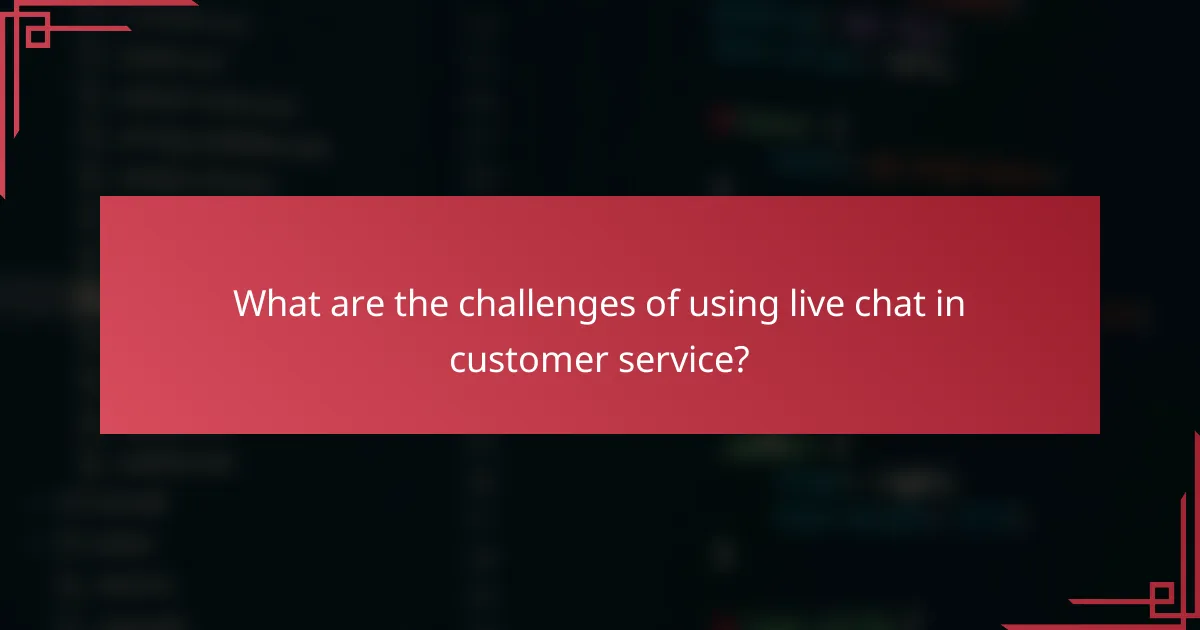Live chat has emerged as a vital tool for enhancing customer satisfaction and engagement by offering immediate assistance and personalized support. By facilitating real-time communication, businesses can swiftly address inquiries, leading to improved customer experiences and loyalty. Implementing effective live chat solutions involves choosing the right platform, integrating it with existing systems, and training representatives to maximize its benefits.

How does live chat impact customer satisfaction in the UK?
Live chat significantly enhances customer satisfaction in the UK by providing immediate assistance and personalized support. This real-time communication channel meets customer expectations for quick responses, leading to improved overall experiences.
Increased response speed
Live chat allows businesses to respond to customer inquiries almost instantly, often within seconds. This rapid response time is crucial in retaining customer interest and reducing frustration, especially compared to traditional methods like email or phone calls, which can take longer.
For example, customers using live chat typically receive answers in single-digit minutes, while email responses may take hours or even days. This immediacy can lead to higher satisfaction rates as customers feel valued and prioritized.
Higher resolution rates
Live chat often results in higher resolution rates for customer issues. The ability to address concerns in real-time allows agents to clarify details and provide solutions more effectively than other communication methods.
Studies show that businesses utilizing live chat can achieve resolution rates exceeding 70%, compared to lower rates for email or phone support. This efficiency not only resolves issues faster but also enhances customer trust and loyalty.
Personalized customer interactions
Live chat enables personalized interactions, allowing agents to tailor responses based on customer data and previous interactions. This level of customization fosters a stronger connection between the customer and the brand.
For instance, agents can access customer profiles during chats, enabling them to reference past purchases or preferences. This personal touch can significantly improve the customer experience, making individuals feel recognized and appreciated.

What are the benefits of live chat for customer engagement?
Live chat significantly enhances customer engagement by providing immediate support and fostering real-time communication. This tool allows businesses to address customer inquiries swiftly, which can lead to higher satisfaction and loyalty.
24/7 availability
Live chat enables businesses to offer round-the-clock support, ensuring customers can reach out at any time. This constant availability can be particularly beneficial for companies with a global customer base, accommodating different time zones and schedules.
By utilizing chatbots for after-hours inquiries, businesses can maintain engagement even when human agents are unavailable. This approach not only improves customer satisfaction but also reduces the likelihood of lost sales opportunities.
Proactive customer outreach
Proactive customer outreach through live chat involves initiating conversations with visitors based on their behavior on the website. For instance, if a customer lingers on a product page, a chat prompt can appear, offering assistance or answering questions.
This strategy can significantly enhance engagement, as it demonstrates attentiveness and encourages customers to interact. Implementing proactive chat can lead to increased conversion rates and improved customer experiences.
Enhanced user experience
Live chat contributes to an enhanced user experience by providing instant answers to customer queries, which can reduce frustration and improve navigation. Customers appreciate the convenience of getting help without having to navigate away from the webpage.
Moreover, integrating live chat with other support channels, such as email and phone, creates a seamless experience for users. This holistic approach ensures that customers receive consistent support across various platforms, fostering loyalty and trust in the brand.

How can businesses implement live chat solutions effectively?
Businesses can implement live chat solutions effectively by selecting the right platform, integrating it with existing systems, and training customer service representatives. These steps ensure that the live chat feature enhances customer satisfaction and engagement while streamlining communication processes.
Choosing the right platform
Selecting the right live chat platform is crucial for meeting business needs. Consider factors such as ease of use, scalability, and integration capabilities with other tools. Popular options include Zendesk, Intercom, and LiveChat, each offering unique features tailored to different business sizes and industries.
Evaluate pricing models as well, as some platforms charge per agent while others offer flat rates. Look for platforms that provide free trials to test functionality before committing.
Integrating with existing systems
Integrating live chat solutions with existing customer relationship management (CRM) systems and other software is essential for seamless operations. This integration allows for better tracking of customer interactions and improves data accessibility across departments.
Ensure that the chosen live chat platform supports integration with your current systems, such as email marketing tools or e-commerce platforms. This will help maintain a unified customer experience and streamline workflows.
Training customer service representatives
Training customer service representatives on how to use the live chat system effectively is vital for maximizing its potential. Provide comprehensive training sessions that cover platform features, communication best practices, and troubleshooting common issues.
Encourage representatives to adopt a friendly and professional tone while engaging with customers. Regularly update training materials to reflect any changes in the platform or company policies, ensuring that staff remain well-informed and capable of providing excellent service.

What are the key metrics for measuring live chat success?
The key metrics for measuring live chat success include customer satisfaction score (CSAT), net promoter score (NPS), and first response time (FRT). These metrics provide insights into customer experience, loyalty, and the efficiency of the live chat service.
Customer satisfaction score (CSAT)
Customer satisfaction score (CSAT) gauges how satisfied customers are with their live chat interactions. Typically measured through post-chat surveys, customers rate their experience on a scale, often from 1 to 5 or 1 to 10.
A high CSAT score, usually above 80%, indicates that customers are pleased with the service they received. To improve CSAT, ensure that agents are well-trained and equipped to resolve issues efficiently.
Net promoter score (NPS)
Net promoter score (NPS) assesses customer loyalty by asking how likely customers are to recommend your service to others. Responses are categorized into promoters, passives, and detractors, which helps identify overall customer sentiment.
A strong NPS, generally above 50, suggests a loyal customer base. To enhance NPS, focus on delivering exceptional service and addressing any recurring issues that may lead to customer dissatisfaction.
First response time (FRT)
First response time (FRT) measures how quickly a customer receives an initial reply after initiating a chat. This metric is crucial as it directly impacts customer satisfaction and can influence their perception of your service.
Ideally, FRT should be within a few minutes to keep customers engaged. To optimize FRT, utilize automated responses for common inquiries and ensure adequate staffing during peak hours to handle incoming chats promptly.

What are the challenges of using live chat in customer service?
Live chat in customer service presents several challenges, including managing high volumes of inquiries, ensuring consistent quality of service, and integrating AI and automation effectively. Addressing these issues is crucial for maintaining customer satisfaction and engagement.
Managing high volumes of inquiries
Handling a large number of inquiries simultaneously can overwhelm customer service teams. When chat volume spikes, response times may increase, leading to customer frustration. Implementing a tiered support system can help prioritize urgent issues and manage workload more effectively.
Consider using chatbots for initial interactions, which can handle basic questions and free up human agents for more complex inquiries. This approach can significantly reduce wait times and improve overall service efficiency.
Ensuring consistent quality of service
Maintaining a high standard of service quality across all interactions is essential for customer satisfaction. Variability in agent performance can lead to inconsistent experiences for customers, which may harm the brand’s reputation.
Regular training and performance monitoring can help ensure that all agents provide a uniform level of service. Establishing clear guidelines and using quality assurance tools can further enhance consistency in customer interactions.
Integrating AI and automation
Incorporating AI and automation into live chat can streamline operations but poses its own challenges. While AI can handle routine inquiries efficiently, it may struggle with complex issues that require human empathy and understanding.
To effectively integrate AI, start by identifying common customer queries that can be automated. Ensure a seamless transition from AI to human agents for more complicated issues, maintaining a smooth customer experience throughout the interaction.

How does live chat compare to other customer service channels?
Live chat is often preferred for its immediacy and convenience compared to other customer service channels. It allows for real-time communication, which can significantly enhance customer satisfaction and engagement.
Live chat vs. email
Live chat offers instant responses, while email typically involves waiting hours or even days for a reply. Customers often appreciate the immediacy of live chat, which can lead to quicker resolutions and higher satisfaction rates.
However, email allows for more detailed communication and can be more suitable for complex issues that require documentation. Businesses should consider using both channels to cater to different customer needs.
Live chat vs. phone support
Live chat provides a text-based alternative to phone support, allowing customers to multitask while seeking assistance. Unlike phone calls, which can involve long wait times, live chat often connects users to agents quickly, improving the overall experience.
On the other hand, phone support can be more effective for urgent matters requiring immediate clarification. Companies should evaluate their customer demographics to determine the best mix of live chat and phone support.
Live chat vs. social media
Live chat is typically more structured and focused than social media interactions, which can be more casual and public. While social media allows for broad engagement and brand visibility, live chat ensures private, one-on-one conversations that can lead to faster issue resolution.
Social media can also be a platform for customer feedback and brand interaction, but it may not provide the same level of personalized support that live chat offers. Businesses should integrate both channels to maximize customer engagement and satisfaction.



